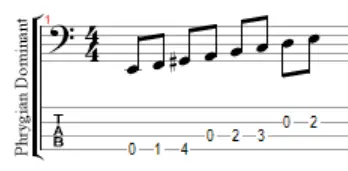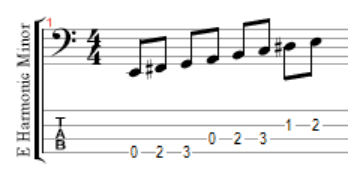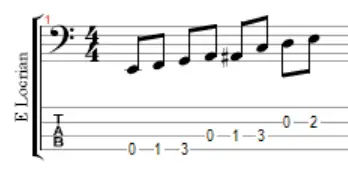While you don`t need to read sheet music to play bass in a metal band, knowing the most common metal bass scales is extremely helpful.
Not only will this make you better equipped to learn new songs faster. It will also improve your songwriting abilities and help you know which rules to break when it`s time to break them.
Therefore, I`m going to show you 9 essential metal bass scales that will help you improve as a bassist. With these scales, you will be able to play the vast majority of metal songs out there. They will also help you write heavy and unique basslines.
All of the scales below are listed in E. Every scale can be played in any key by moving every note of the scale an equal amount of steps up or down.
1. The Natural Minor Scale (Aeolian)
- E minor: E-F#-G-A-B-C-D
- Notable steps: Minor third, minor sixth, minor seventh
- Feels: Melancholy
If you are looking to become a metal bassist, the natural minor scale is one out of two bread-and-butter scales you need to know.

Most music modern music is written in either the natural minor or the natural major scale. While there are metal songs written in the major scale, it is generally thought of as “sounding too happy” for metal. Thus, the minor scale is a go-to choice for most metal bands.
It is also a scale that lends itself well to all sub-genres of metal. The easiest metal songs to play on the bass are mostly written in minor scales, but it`s also used in everything from prog metal to tech-death.
Here are some well-known examples of metal songs that are written in this scale:
| Band | Song | Key |
| Dio | Rainbow In The Dark | A Minor |
| Metallica | Nothing Else Matters | E Minor |
| In Flames | Come Clarity | A# Minor |
| Black Sabbath | Paranoid | E Minor |
| Five Finger Death Punch | Wrong Side Of Heaven | E Minor |
| Eluveitie | Inis Mona | D Minor |
| Nightwish | Sleeping Sun | D Minor |
| Mudvayne | World So Cold | G Minor |
| Avenged Sevenfold | So Far Away | E Minor |
I`ve heard the natural minor scale oftentimes be referred to as a “sad” scale. It certainly can be, and sad songs are usually written in a minor key. However, this is a gross oversimplification of what this scale can be used for.
It can be used to make a song sound tough, which many trash, nu, and heavy metal bands have done. Iron Maiden has used it to create melodic backdrops for stories from history and mythology. Folk Metal bands have used it for folklore stories and power metal bands have used it to write songs about bravery and heroism.
It`s a melancholy-sounding scale, but this must not be mistaken for it only being fitting for writing sad songs. Rather, natural minor is a versatile scale that can be used to write almost any kind of metal music.
2. The Chromatic Scale
- E Chromatic: E-F-F#-G-G#-A-A#-B-C-C#-D-D#
- Notable steps: All of them
- Feels: Dissonant
Your other bread-and-butter scale is the chromatic scale. While most western scales consist of seven out of twelve possible notes, the chromatic scale consists of all twelve of them.

While some don`t see the point of the chromatic scale as it sounds dissonant, this is exactly what makes it a great fit for metal. The dissonance it provides can make riffs heavier, sinister, and more brutal. Thus, it is a staple scale in metal, and the heavier the sub-genre the more likely you are to find songs that use it.
This works because a lot of metal is also not based on modal harmony the same way most genres are. Simply put, this means that melodies and chords don`t have a clear harmonic foundation.
Thus, the chromatic scale enables metal musicians to write dissonant riffs that wouldn`t fit over chords in the traditional sense. It also allows them to play power chord progressions that don`t fit perfectly with the perceived key of the song.
One of the most iconic metal bass riffs of all time is as chromatic as it gets. I`m talking about Cliff Burton`s opening riff on “For Whom The Bell Tolls.” The first 4 notes of it are D-C#-C-B. This chromatic descending gives the riff a dissonant, evil, and heavy character.
Another great showcase of how the chromatic scale can work is “Holy Wars… The Punishment Due” by Megadeth. Both the intro and verse riff disregard common scales completely. Yet, the riffs sound cohesive and the dissonance makes it immediately clear that this is a metal song.
3. Phrygian Mode
- E Phrygian: E-F-G-A-B-C-D
- Notable steps: Minor second
- Feels: Exotic
While most scales have a major second, the Phrygian mode has a minor second instead.
Modes explained: “Modes” are formed by playing a scale from a different starting point than the tonic. For example, The Phrygian Mode is just the minor scale played from the 5th step of the scale rather than the 1st. E is the 5th step of the A minor scale. Thus, A minor and E Phrygian have the same notes in them, and E Phrygian is a “mode” of A minor.
Me – Who also struggled to tell the difference when I first started learning music theory
The mode is named after the Greek kingdom of Phrygia where it was commonly used. However, in modern western music, it is commonly used to make songs simply sound non-western.

While this effect can work in all genres of music, it has been used by many metal bands to the point where it has become a staple in the genre.
For a well-known example, “Wherever I May Roam” by Metallica is played in Phrygian. As the lyrics of the song are (simply put) about traveling, the Phrygian mode fits this theme perfectly.
4. Phrygian Dominant Mode
- E Phrygian Dominant: E-F-G#-A-B-C-D
- Notable steps: Minor second and major third
- Feels: Even more exotic
The Phrygian dominant mode also changes the third note of the mode from minor to major. As a result, the gap between the second and third becomes one and a half steps. This is uncommon in western scales and further extenuates the exotic feel of the Phrygian dominant mode.

“Nile” is a Death Metal band that bases their sound, image, and lyrics on Egyptian themes. Therefore, they commonly use Phrygian Dominant to fit this theme.
Their song “Sarcophagus” is a great demonstration of how the use of both the minor second and major third can lead to an exotic sound. This is also a band that perfectly demonstrates how heavy this mode can sound when used right.
For more technically profcient basslines, see my list of the best metal bass songs ever.
5. Harmonic Minor
- E Harmonic Minor: E-F#-G-A-B-C-D#
- Notable steps: Major seventh
- Feels: Sinister
The only difference between harmonic minor and natural minor is that the harmonic minor scale has a major seventh.

While at first glance, this would make one think that the scale will sound happier, this is far from the case. Harmonic minor is often used to make songs sound sinister and evil. This is in large part because of the relationship between the 7th, 1st, 2nd, and 3rd steps.
For example, In E harmonic minor these notes are D#-E-F#-G. Between them, they are only one half-step away from being chromatic.
This makes harmonic minor an amazing scale for playing metal as a bassist. It gives you the dissonant and evil sound of the chromatic scale, while still grounding the music in a scale.
Behemoth makes full of this in their song “The Satanist”. The major seventh is played together with the tonic in both the opening and verse riff, which further extenuates the sinister character of the song.
6. Locrian Mode
- E Locrian: E-F-G-A-A#-C-D
- Notable steps: Minor second, diminished 5th
- Feels: Unresolved
Locrian mode is not a mode that sees a lot of use. This is because it is a hard mode to work with, and to many listeners, it feels like it doesn`t have a clear harmonic foundation.

What it does have though, is a tritone. It also has a minor second like the Phrygian mode. Thus, this mode lends itself well to metal as it can sound both evil and dissonant, as well as exotic and unique.
Perhaps the most well-known metal song in the Locrian mode is Metallica`s “Sad But True”. It makes great use of the tritone to sound heavy throughout the main riff, verse, and chorus.
7. Dorian Mode
- E Dorian: E-F#-G-A-B-C#-D
- Notable steps: Major sixth
- Feels: Hopeful
Dorian mode is one of the most common jazz bass scales, but it`s not as frequently used in metal. However, it is a mode that serves a unique purpose and is useful to know for aspiring metal bassists.
It is similar to the natural minor scale, but instead of a minor sixth, it has a major sixth. This gives the mode a melancholy, yet hopeful character.

Dorian can thus be a great mode to use for writing songs that are sad, but still have a sense of aspiration and hope to them. It is also a good way to change things up from chromatic and natural minor, without making a song feel too happy.
“Fear Of The Dark” by Iron Maiden has one of the most iconic intros in all of metal. While most of the song is played in Natural minor, the intro is played in the Dorian mode.
8. The Major Scale
- E major: E-F#-G#-A-B-C#-D#
- Notable steps: Major third, Major sixth, major seventh
- Feels: Happy
As I said earlier, the major scale is seldom used in metal. Despite being a fairly straightforward scale, it is by far the hardest scale on this list to write metal in.

However, many bands have still managed to write great metal songs in major keys.
Fitting uses of the scale include power metal bands using it to write triumphant songs, such as Dragonforce`s “Heroes Of Our Time”. More progressive bands such as Opeth also sometimes write parts of a song in a major key while the rest of it is played in a minor key.
Most noteworthy, Iron Maiden made a song about “The Number Of The Beast” in a major key. Not only did it work, but it became one of the most iconic metal songs of all time.
9. Melodic Minor
- Ascending E Melodic Minor: E-F#-G-A-B-C#-D#
- Descending E Melodic Minor: E-F#-G-A-B-C-D
- Notable steps: Major sixth and Major seventh when ascending
- Feels: Tense
It can be debated whether melodic minor can be called a scale at all. This is because half the time, it is identical to the natural minor scale. However, the scale changes when ascending, and the 6th and 7th steps change from minor to major.

Thus, few songs can be said to be played completely in melodic minor. Rather, it is a tool that is used occasionally to create a further sense of resolution when returning to the tonic.
Melodic minor is most commonly used in progressive and technical forms of metal. It can be a difficult tool to incorporate well, especially so when trying to keep a song heavy.
Thus, if you want to make your basslines more melodic, more proggy, or more technical, melodic minor can be a great tool. Just make sure the whole band is on board with what you are doing. It can create some serious dissonance between the bass and guitars if you suddenly start incorporating this scale out of nowhere.
Conclusion
These metal bass scales will give you a solid foundation for playing the bass in any type of metal band. While the bass can be hard to hear in metal, using scales to add unique melodies to your lines is one out of many ways you can cut through the mix.
The minor scale and its modes will enable you to provide a melodic and heavy backdrop in everything from heavy metal to folk metal. Mastering the chromatic scale lets you play dissonant, heavy, and evil-sounding grooves that are a staple of the genre.
Once you get a firm grasp on what makes metal sound like metal, you can also start incorporating the major and melodic minor scales. These are much more demanding scales to write in, but they will also make you stand out when you are able to pull it off.
If you are completely new to metal bass scales I recommend focusing on the natural minor and the chromatic scales at first. Most of the time, these two scales are all you need, and it`s not uncommon for metal bassists to only use these two scales.
Knowing your scales is a crucial part of playing bass. An equally important part of playing metal bass is to set your EQ for a heavy sound. Therefore I wrote a guide on metal bass EQ that will help you get the type of tone you want out of your bass guitar.

